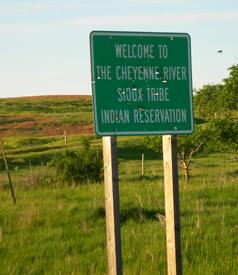Here's why Keith Olbermann matters to Indians:
Olbermann's Support for South Dakota Tribe Points Way to More Inclusive Indian Country Coverage
By Rose Aguilar
On January 21, 2010, a devastating blizzard and snowstorm hit the area, one of the poorest in the country, knocking down over 3,000 utility poles. Residents were without electricity, water or heat in subzero temperatures for weeks. The tribe declared a state of emergency. "The government has done next to nothing for the Native Americans, who on a nice, sunny spring day there still face unemployment of 85 percent," Olbermann said sternly. "Doing nothing for these people, an American tradition since at least 1776."
He then directed viewers who wanted to donate to the Countdown website, where they would find a link to the Cheyenne River Sioux Tribe storm relief fund.
There were no videos or photos of the devastation. There was no interview with a tribal member. It was a one-minute commentary. According to Tribal Chairman Joe Brings Plenty, Olbermann's call for donations, coupled with community efforts and matching money from the Bush and Northwest Area Foundations, brought in $975,000. Daily Kos blogger Bill in Maryland posted a diary with donation links for neighboring tribes.
Azocar says part of the problem is that reporters often use studies that break things down by race in their articles, and Native Americans are always left out. "You see blacks, whites, Asians and Hispanics, but never Native Americans. It's almost a population, that for statistical purposes, doesn't exist," she said.
A 2002 Reading Red Report conducted by NAJA analyzed 1,133 articles appearing from 1999-2001 in nine of the largest circulation newspapers in the U.S., including the New York Times, USA Today, and The Washington Post. According to the report, "the best stories simply reflected good-quality and fair-minded reporting; writing and editing applied to Native America. They treated Native Americans as people rather than historical figures. They explained to readers the unique status of federally recognized tribal nations as sovereign governments within the United States. They acknowledged the depth and diversity of Native American communities." Most stories, however, failed to accurately represent Indian Country. Mascot team names, casino gaming and "on the rez" stories made up the majority of stories.
Of course, in the grand scheme of things, that isn't much. It's roughly two stories per state. Someone in Los Angeles might see a blurb about a powwow in San Diego, two hours away, or a museum exhibit in Northern California. That's not enough to change the impression that Indians have basically vanished. That only a few remain, eking out a living in the desert somewhere with a lonely casino.
For more on the subject, see How Journalists Frame the Question and Native Journalists = Foreigners?!


No comments:
Post a Comment